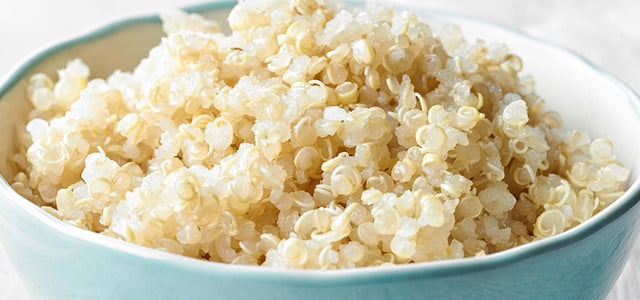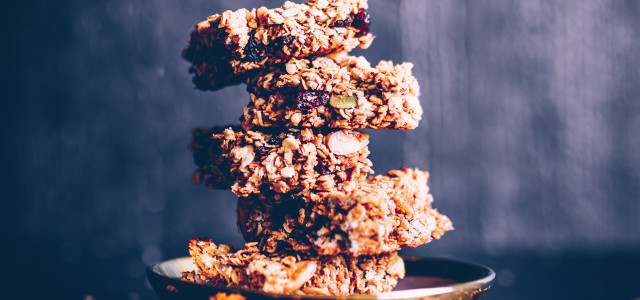Do you know why it’s so important to wash quinoa before eating it? Learn this and more about quinoa’s many benefits (and a simple quinoa recipe) here.
Quinoa, a staple food in the Andes Mountains of South America, has been cultivated for approximately 6,000 years. This nutrient-rich grain was highly valued by the Incas, who called it the “mother grain.” However, Spanish colonizers dismissed quinoa as peasants’ food and banned its consumption, contributing to its relative obscurity in North America until a few decades ago.
In the 1990s, the benefits of organic quinoa were rediscovered by organic food stores and the alternative-cooking movement, which helped elevate the grain to its current status as a gluten-free superfood.
- Interested in learning more about why so many people prefer organic food? Check out: What Does Organic Mean? Definition and Labels to Look Out For.
Once revered by the Incas as a wonder crop, quinoa has become a popular substitute for rice, couscous and oatmeal due to its versatility and nutritional benefits. This versatile grain is now featured in a wide variety of recipes.
Quinoa is also cultivated in the United States, specifically in high-altitude regions like Colorado. However, it has a short growing season, which may impact its availability and production.
What Is Quinoa and What Kinds Can You Buy?
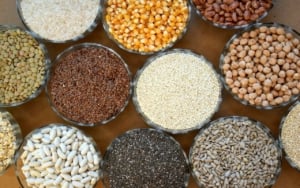
Quinoa is an ancient annual cultivated plant and belongs to the amaranth family. The sprouts and leaves are edible; however, the plant’s seeds are more sought-after. You can cook them just like rice. These are the different types of quinoa:
- White quinoa is the most common type and often the cheapest. It’s lean and has a nutty flavor. Cooking time is 10 to 15 minutes.
- Black quinoa tastes similar to white but is slightly firmer. Cooking time is 15 to 20 minutes.
- Red quinoa, like black quinoa, takes longer to cook. This quinoa retains its shape and looks great on your plate. Red quinoa goes particularly well in salads. Cooking time is 15 to 20 minutes.
- Puffed quinoa is like the Inca’s popcorn. Like Quinoa flakes, you can find it in various natural cereals.
You’ll often find mixes of two or three different colors. Unlike rye or wheat, quinoa doesn’t belong to the family of bison grasses and doesn’t contain gluten. The plant is therefore deemed a “pseudocereal” based on its apparent similarity to grain.
Growing quinoa is undemanding; simply seed in loose dirt patches free of weeds. Compost and watering are rarely necessary and can even reduce the harvest yield.
Quinoa Benefits and Nutrition Facts: Is It Good for You?
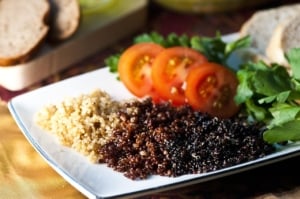
The Inca worshipped quinoa as a miracle plant — and rightly so: Organic quinoa’s benefits are vast and contribute to its growing international popularity. Quinoa is an excellent source of essential amino acids like lysine, tryptophan and cystine, providing an array of unsaturated fats. Quinoa is also rich in minerals, including magnesium (approx. 300 mg), iron (approx. 8 mg), potassium (approx. 800 mg) and calcium (approx. 120 mg), as well as manganese.
Quinoa’s benefits make it a good protein pick for vegans, stirring up quite a bit of hype — similar to the protein-packed superfood edamame. However, quinoa alone won’t isn’t enough for optimum health. A balanced diet of fruit, vegetables and grains is essential for energy and long-term wellness.
Quinoa: A Boost of Energy and Carbs
Choosing quinoa as a grain alternative for a low-carb diet makes little sense. The pseudocereal is packed full of energy and contains up to 400 calories per 100 grams. This energy is also delivered through unsaturated fats — but it primarily comes from carbohydrates.
Nonetheless, before the body can use these complex carbohydrates, they must first be broken down. It’s why you feel full for longer after eating quinoa. That’s one of organic quinoa’s benefits; it will help you avoid hunger pangs throughout the day.
Why You Should Rinse Quinoa Before Eating It
Like many other foods, quinoa has specific properties that aren’t so healthy for us to eat. For the plant to protect itself from natural threats, the grain shells are coated with bitter saponins. These saponins can harm humans’ intestines and blood cells if digested. Furthermore, raw quinoa grains are not fit for consumption at all. Even after the shell is removed, you should always wash quinoa thoroughly and cook it to remove any remaining saponins.
People with gastrointestinal diseases and children under two years should be particularly careful, as their intestinal lining may not be robust enough to handle saponins. The substance can enter the bloodstream and attack red blood cells.
In the US, commercially sold quinoa is predominantly sold processed and rinsed. However, especially if you’re buying from the bulk section of your supermarket, it’s always a good idea to rewash quinoa before you use it for cooking.
Quinoa Benefits: Is It Gluten-free?
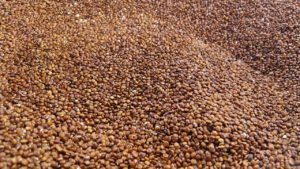

Quinoa is a gluten-free pseudocereal, making it an excellent alternative for those with celiac disease or other forms of gluten intolerance. As it is not a grass, quinoa naturally does not contain gluten. This characteristic makes it a valuable option for side dishes in gluten-free diets.
However, using quinoa flour as a direct substitute for wheat flour in baking can be challenging. Gluten, a protein complex found in wheat, provides elasticity to dough, ensuring that bread and cakes have a light and airy texture. Since quinoa lacks gluten, baked goods made solely with quinoa flour may not achieve the desired consistency. To reduce the gluten content in a recipe without compromising the texture, you can replace a small portion of the wheat flour with quinoa flour.
In addition to quinoa-based side dishes, you can find gluten-free noodles made with quinoa. However, it’s important to note that consuming quinoa as a gluten-free alternative is only necessary if you have a medical reason, such as celiac disease or gluten intolerance.
There is no benefit in adopting a gluten-free diet as a preventative measure without an existing health-related need. It is also worth mentioning that gluten-free noodles often contain more cornmeal and rice flour than quinoa.
Should You Incorporate Quinoa Into Your Diet?
This nutritious and gluten-free grain offers numerous health advantages. Quinoa benefits include being energy-dense, with a calorie-to-nutrient ratio higher than most other grains. So, it’s a valuable addition to a balanced diet. Consuming quinoa in moderate portions can help provide essential nutrients without significantly increasing your overall calorie intake.
While incorporating quinoa into your meal plan can be beneficial, it should not replace a well-rounded diet. A more comprehensive approach to improving your nutritional habits would involve incorporating a variety of regionally-sourced, wholesome foods to ensure a diverse and balanced intake of essential nutrients.
Quinoa Benefits: What to Consider When Purchasing
As an integral element of the superfood hype spreading across the country, quinoa is available everywhere — unfortunately, only seldom as a Fairtrade product. Even discount stores quite consistently have it in stock. The price range for this pseudocereal can vary from $5 to $12 per pound for natural organic seeds. Puffed quinoa or quinoa flakes are a bit more expensive due to the longer processing process.
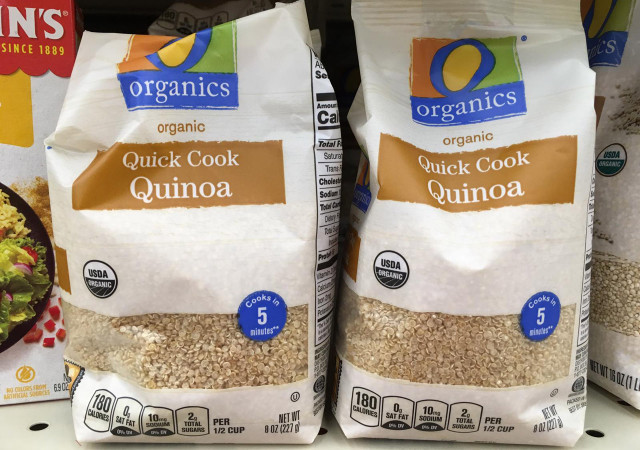


The easiest way to get your hands on quinoa is by shopping at health food and natural and organic food stores, such as Whole Foods, Trader Joe’s, Good Harvest or LifeSource.
Also interesting: Whole Foods Alternatives That Are Actually Affordable
No matter which kind your quinoa recipe calls for, pay attention to the processing methods detailed on the packaging and closely inspect it for organic or Fairtrade certification labels when shopping. Only this way can the farmers in the Andes of Peru and Bolivia justly benefit from the sales of their labor-growing quinoa.
Remember: Buying in-store saves time, money and the environment. If you’re going to order online, buy in bulk (in realistic quantities) and make it last.
Try to avoid several pointless products, whether natural organic or not:
- Boil-in-bag packaging: Like rice, you can also find quinoa in ready-for-the-pot plastic bags. It can be a time-saver, but in reality, it only results in unnecessary plastic waste.
- Quinoa snacks: The Inca grain is often advertised as a key ingredient in many snacks due to its blooming reputation as a superfood. Take a closer look at the product contents — you’ll notice that the total quinoa content in these light bites usually hovers around but a few percent.
- Convenience products: It’s common for processed quinoa-cereal mixes to contain palm oil. Try your hand at one of the countless quinoa breakfast recipes yourself.
A Basic Quinoa Recipe and Tips
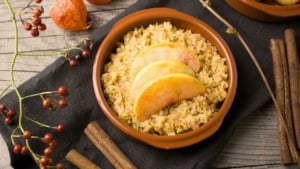

Quinoa is a versatile grain that can be served in various ways, with the most popular recipe being a side dish prepared similarly to rice. Here are some tips and ideas for preparing and enjoying quinoa:
- Cook quinoa by combining the seeds with twice the amount of water in a pot and bringing it to a boil. Then, reduce the heat and let it simmer for approximately 10 minutes. Remove the pot from the heat and allow the quinoa to soak for an additional 10 minutes.
- Enhance the flavor by seasoning the cooked quinoa with a pinch of salt and a touch of butter or olive oil to bring out its natural nuttiness.
- Get creative with your quinoa salads by incorporating various ingredients such as lemon zest, beans, zucchini, or mint. Quinoa also goes great in a vegan budda bowl!
- Try a refreshing summer salad featuring quinoa with avocado, mango, and onion for a delightful combination of flavors.
- For a South American-inspired spicy dish, experiment with chili con quinoa, replacing meat with vegan ground beef for a plant-based alternative.
- This quick quinoa pudding makes a filling, nutricious breakfast or tasty afternoon snack.
With its numerous substitution and serving options, quinoa allows for endless culinary creativity in your meal planning.
Quinoa’s Sustainability Concerns
Quinoa’s sustainability has come into question due to the environmental impact and challenges faced by local producers. Over 95% of global quinoa production takes place in Peru, Bolivia, and Ecuador, with long transport routes from the fields contributing to significant fossil fuel emissions and climate impact.
The benefits of quinoa may not always outweigh the environmental risks, local producer challenges, or overall farm-to-plate sustainability. To make responsible choices when purchasing quinoa, consider opting for organic, non-local products, and be mindful of how often you use this nutrient-dense grain as a protein substitute in your recipes. By making informed decisions, consumers can play a role in supporting the sustainable growth of this superfood.
For a more in-depth analysis of quinoa’s sustainability, we recommend reading our article, The Truth About Quinoa: Is This Superfood Sustainable?
Read more:
- 7 Chia Seed Substitutes & Ways To Use Them
- Can You Eat Coffee Beans? Benefits, Limits and Recipes
- Rose Hip Syrup Recipe: A Vitamin C Infusion
Do you like this post?






